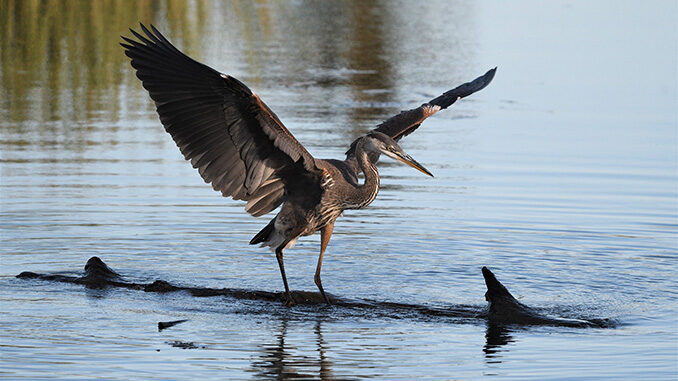
By Margaret Mccormick
New York is home to art trails, wine trails and culinary trails. But did you know there is also a New York State Birding Trail?
Yes — a trail devoted to our feathered friends.
The New York State Birding Trail is just what it sounds like, but it’s not a physical, connected trail. The trail list and map, a project of the state Department of Environmental Conservation, is more like a central clearinghouse of the top-flight bird-watching sites throughout the state. The list highlights 300 sites in nine regions, including Central New York and the Finger Lakes, the Capital region, and the Adirondacks-North Country.
Check out the list here: www.dec.ny.gov/animals/124045.html
And check out the NYS Birding Trail map: www.dec.ny.gov/animals/109900.html#Map_of_Trail
The popularity of birdwatching soared during the pandemic and what seemed like never-ending stay-at-home in 2020 and 2021, according to the National Audubon Society. Sales of bird feeders, bird food, birdbaths and other bird-related merchandise boomed as people took to backyard birdwatching as a safe, socially distant activity — much like people took to gardening and canning.
The beauty of birdwatching is that it can be done by anyone anywhere, regardless of age, ability or background, the DEC notes. No special skills are required. Beginner birders might want to invest in binoculars and a field guide, suggests the Cornell Lab of Ornithology, at Cornell University in Ithaca.
If you have a smartphone, you can take photos of birds and notes on birds — and identify birds quickly and easily. The Merlin bird app, developed by the lab and launched in 2014, is designed to help people answer the eternal question, “What’s that bird?’’ For more information, visit https://merlin.allaboutbirds.org.
Want to venture off your porch, patio or deck and have a look at birds other than robins, sparrows and crows?
There’s no need to travel very far. Outstanding opportunities to observe birds in Onondaga County include Beaver Lake Nature Center in Baldwinsville, the Camillus Forest Unique Area, Green Lakes State Park in Fayetteville, Old Erie Canal State Historic Park (DeWitt and points east), the Hamlin Marsh Wildlife Management Area in Clay, and the Three Rivers Wildlife Management Area in Lysander.
Beaver Lake Nature Center, part of the Onondaga County parks system, offers weekday bird walks on Monday and Tuesday through June 27 — check out the center’s website and calendar for these and other bird-related activities. The guided walks are described as relaxing and are designed for both experienced birders and those who are new to birding.
Visitors can expect to see spring migrants and summer residents of the park’s meadows, lakeshore, forest, hedgerows and bog.
There are other notable NYS Birding Trail sites in the Central-Finger Lakes region. Check websites for birding and other summertime events:
• Derby Hill Bird Observatory, on Lake Ontario in Oswego County, is considered one of the most important hawk sites in the northeastern United States. The observatory is owned and operated by the Onondaga Audubon Society, and it attracts thousands of hawks, snow geese and other birds as they migrate north each spring. Summer isn’t as dramatic as spring and fall, the website notes, but plenty of small birds, as well as bald eagles, can be spotted from the trails and lookouts at Derby Hill.
Information: https://onondagaaudubon.com/what-is-the-derby-hill-bird-observatory/
• Sterling Nature Center is a 1,400-acre Cayuga County park with 10 miles of walking, hiking, and birdwatching trails and scenic views of Lake Ontario and its bluffs. The center is noted for its Great Blue Heron rookery, and visitors can watch the herons from an observation deck (spring). Great horned owls and bald eagles also nest in the area.
Information: https://www.cayugacounty.us/1697/Events-at-Sterling-Nature-Center
• The Montezuma National Wildlife Refuge, managed by the U.S. Fish and Wildlife Service, is a major stopping point for migrating birds. If you travel the New York State Thruway, you’ve probably seen the eye-catching sculpture of a bald eagle as the highway passes through the refuge in Seneca Falls. That’s just one section of the 10,000-acre refuge. Hundreds of species of birds, including bald eagles, are known to nest there. Birds can be observed from nature trails, towers, and decks, and the Montezuma Visitor Center is open daily from April through November.
Information: https://www.fws.gov/refuge/montezuma
• The Montezuma Audubon Center in Savannah, meanwhile, is a state-owned facility operated jointly by the state DEC and the National Audubon Society. It’s part of the 50,000-acre Montezuma Wetlands Complex and is designated an Important Bird Area. Programs include guided birding tours, guided hikes, and private birding tours. The center is open Tuesday to Saturday (10 a.m. to 4 p.m.) and nature trails are open daily, sunrise to sunset.
Information: https://ny.audubon.org/montezuma
